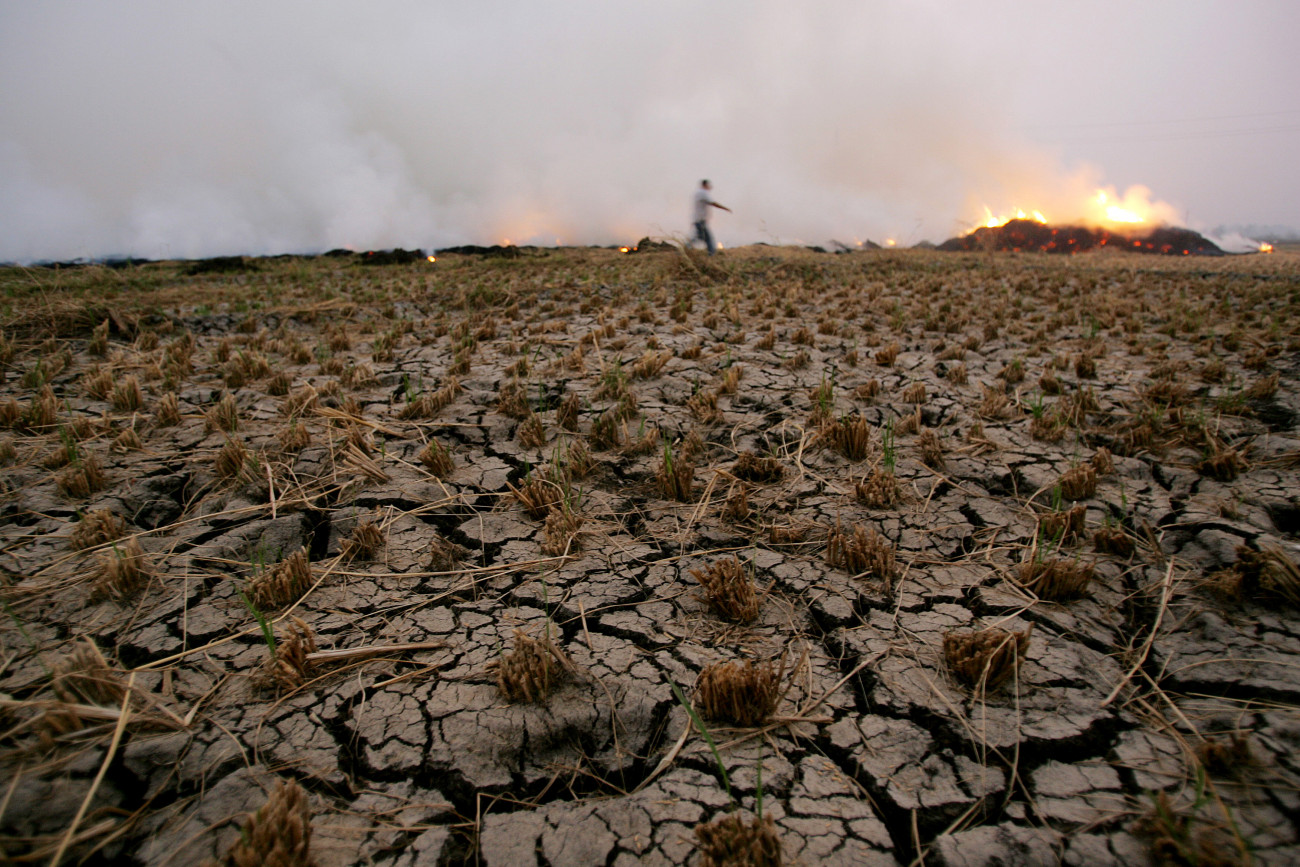

Introduction
The Middle East and North Africa faces a host of major environmental challenges, from water scarcity and food insecurity to climate change adaptation. In recognition of Earth Day on April 22 and in conjunction with MEI's Climate Week 2021 events, we asked experts and scholars to weigh in with their thoughts on the most pressing environmental issues facing the region.
Viewpoints
-
Aisha Al-Sarihi
Aisha Al-Sarihi

The Middle East and climate change: Transboundary challenges and solutions
Given its geographic location and arid climate conditions, the Middle East is one of the most vulnerable regions to climate stresses, especially rising temperatures and water scarcity. According to the World Resource Institute’s Aqueduct Water Risk Atlas, the Middle East is the most water-stressed region on Earth, possessing only 1% of the world’s total renewable freshwater resources. Rising temperatures and extended periods of drought, combined with growing populations, socioeconomic development, and urbanization, put further pressure on scarce water resources, posing serious threats to lives, livelihoods, biodiversity, economic stability, and human security. Importantly, given the region’s shared geography and natural resources, the impacts of climate change are likely to be felt across borders.
Countries in the Middle East are increasingly aware and committed to addressing these climate stressors, including through building dams and expanding the use of water desalination. While useful, such domestic solutions might create unintended domestic and transboundary risks and vulnerabilities. Given the variation in endowments of natural resources and socioeconomic conditions, states can take advantage of their shared culture, language, and religion to find collective solutions addressing regional climate and environmental issues, including by:
- Realizing that the time to act is now: Being on the front line of climate change, countries in the Middle East should realize that the issue must be addressed urgently and there is no time to waste.
- Embarking on immediate action: Regional governments have created momentum in addressing climate change in terms of both mitigation and adaptation. However, that momentum has largely revolved around establishing initiatives and targets without necessarily linking them to the policies and regulations needed to achieve them. Implementation is equally important. Regional states need to move beyond establishing targets to taking action.
- Enabling local innovations and solutions: Despite the growing interest in addressing climate and environmental issues, most of the technology and know-how needed to do so is imported. While useful, these imports are not necessarily designed for the region, and they typically need to be adapted to suit local conditions. Middle Eastern countries need to take advantage of their large youth populations and enable a national innovation system to ensure that technologies and skills meet local needs and priorities. In 2020, the average investment in research and development (R&D) in the Middle East did not exceed 1% of GDP, which is the minimum required for an effective scientific and technological base set by UNESCO. Regional states should nurture existing institutions, like universities and R&D entities, to enhance technological innovation, improve scientific competence and skills, and support the spread of know-how among relevant stakeholders.
- Working together: Some Middle East countries have shared geographies and natural resources, including shared water resources and marine environments, coastal ecosystems, and agricultural lands. Therefore, climate change impacts are likely to be felt across borders, and if not properly managed, this could lead to conflicts or insecurity. Addressing climate challenges should therefore involve transboundary responses. Given their differences in income and development, Middle East countries can take advantage of regional governance and cooperation, especially in the areas of policy coordination and agenda setting, research and knowledge and information sharing, technical assistance and capacity building, and leveraging finance.
Aisha Al-Sarihi is a non-resident fellow at the Arab Gulf States Institute in Washington.
-
Jamal Saghir
Jamal Saghir

The MENA region faces a triple threat
The Middle East and North Africa (MENA) is a drastically diverse region in terms of socio-economic and political conditions and confronts the triple threat of climate change, rising food and water scarcity, and economic crisis. All three are under fragile contexts of conflict and political instability, exacerbating poverty, inequality, and underdevelopment. However, it is one region where water scarcity accrues, making it the driest and the most water-stressed region in the world and a unique hotspot for adaptation impacts. 18 out of 22 Arab states stand below the renewable water resources annual scarcity threshold of 1,000 cubic meters per capita, and 13 below the absolute water scarcity threshold of 500 cubic meters per capita per year. Indeed, 60% of its population lives currently in areas of high water stress, compared to a global average of only 35%, and 70% of its GDP is also generated in such areas, compared to 22% globally.
Climate change will have dire and severe impacts on the MENA region. Temperatures are rising faster than the global average. Extreme and extended periods of heat will transform both rural and urban areas, exposing cities to a rising heat island effect and decreasing the productivity of agricultural areas, while placing significant strains on already scarce water resources. It is predicted that climatic extremes will worsen in the coming decades. Compounding these effects, the region’s population is projected to double by 2050, putting the MENA region’s resources under enormous pressure.
Climate change also presents a security challenge and can generate conflicts between agricultural and pastoral communities precipitated by climate-exacerbated droughts and water variability. This has been observed in Yemen and Syria. These stresses could increase tensions and conflict between communities and precipitate the need for people to move — impacting the prices of livestock and other goods. In some cases, this could also lead to an increase in malnutrition and disease outbreaks, and adversely impact food security.
The threats linked to climate change in MENA that pose the greatest risk include water scarcity, food availability (including the reliance on imports and foreign markets), and government instability. These threats could be mediated by a range of political, institutional, and societal factors, alongside adaptation policies and investments. The ways in which adaptation measures are designed and implemented can be a key determinant of climate change resilience in the region. This requires the improvement of our knowledge of climate impacts and effective technologies and their application; integration of climate considerations into development policies and plans (e.g., siting and building standards of large infrastructure projects, city design, land use planning, and sound agriculture and irrigation policies); and building local capacity for improved preparedness and adaptation.
We can argue that adaptation in MENA is all about water, and it is central to appreciate how climate change exacerbates water scarcity and thus has implications for water availability and water-dependent sectors such as agriculture, ecosystems, cities, and human health. Thus, an integrated approach is needed, placing water and water-dependent sectors at the center of solutions. This includes prioritizing adaptation action in transboundary water basins, given that over two-thirds of the region’s freshwater resources traverse one or more international boundary, with climate change impacts on those resources having important implications for climate security, water, energy and food security, rural livelihoods, and economic development. Adaptation needs to be mainstreamed in national and sectoral planning, and mainstreaming must seek to maximize synergies across sectors and build coherence at all levels. This requires policy integration and harmonization, horizontally and vertically, at the national level between sectors, at the regional level between regional and national strategies, and at the global level between water-related agendas and national goals and targets.
Jamal Saghir is a Professor of Practice at the Institute for the Study of International Development at McGill University, Montreal, a Distinguished Fellow for Economic and Development at the Institute of Financial Economics, American University of Beirut, and a Senior Fellow at the Payne Institute for Public Policy, Colorado. He is a former Director at the World Bank Group, Washington, DC.
-
Banafsheh Keynoush
Banafsheh Keynoush

Addressing the environmental risks of Iran’s nuclear program
There is growing concern about the safety of Iran’s Bushehr Nuclear Power Plant (NPP), as the country rapidly expands its nuclear program. Iran and Russia are continuing work on the construction of the second and third stages of the Bushehr NPP, located on Iran’s southwestern Gulf shores. But given that the plant is one of the oldest in the Middle East, and sits in an area prone to earthquakes, Iran’s Gulf neighbors have sounded alarm bells.
Russia insists that the new expansion includes the latest safety features, such as Generation III+ technology, and will be closely monitored by the International Atomic Energy Agency (IAEA). But as early as 2011, Russian scientists warned that a Chernobyl-like accident could occur at the Bushehr NPP.
Iranian media is quick to dismiss concerns over the safety of the plant, which add to fears of non-compliance with environmental standards. But environmental activists in Iran are also quietly concerned that the plant is potentially a source of hazardous material that has made its way into Gulf waters, a problem they also blame on tourism, refinery construction, and the militarization of the Gulf region. Still, many pollutants in Gulf waters contain radioactive material that has led to genetic mutations and physical and mental ailments among the population in Iran’s southern coastal areas.
U.S.-imposed sanctions on Iran could slow down the development of the Bushehr NPP. Tehran has already announced that the sanctions could force a shutdown in 2021, which might restrict IAEA access and increase safety concerns if Iran were to use the plant to conduct secret enrichment programs.
More than a decade ago, the Gulf Cooperation Council (GCC) offered Iran a comprehensive dialogue option to address the potential environmental hazards of the Bushehr NPP. Tehran welcomed the idea, but then quickly dismissed it, preferring to engage only with world powers about the fate of its nuclear program.
As those same world powers once again meet with Iran to discuss its nuclear activities, it is high time to agree on common-sense safety measures for the Bushehr NPP, including provisions for ongoing IAEA inspections of the plant as it expands, regardless of the issue of sanctions, as well as guarantees that the plant will only enrich low levels of uranium for the foreseeable future. In addition, steps should also be taken on the regional level, including starting a GCC-Iran dialogue over environmental safety mechanisms for the plant, providing additional technology to ensure its safety, and offering collective, region-wide nuclear power generation alternatives to Iran.
Banafsheh Keynoush is a fellow at the International Institute for Iranian Studies, a team member at the Carnegie-funded Sectarianism, Proxies, and De-sectarianization Project, a member of the Pacific Council, and Co-Chair of the Middle East Forum at the Commonwealth Club of California.
-
Hafsa Halawa
Hafsa Halawa

MENA’s environmental challenges are exacerbated by state failures
The Middle East and North Africa (MENA) remains one of the regions of the world most affected by climate change dynamics. Unlike other parts of the developing world, however, the region is also a major contributor to the problem, as the largest global source for energy resources like oil and gas, one of the top emitters of fossil fuels, and a significant contributor to plastic waste in our oceans. In addition, worsening air quality and rising pollution have increased health risks for citizens, while climate risks related to rising sea levels directly affect a number of regional coastlines, notably in the Mediterranean.
Water security and transboundary water management remain the most obvious risks to regional security. Egypt continues to be stuck in what is now a decade-long dispute with Nile Basin countries over transboundary water management of the river, as Ethiopia embarks on its landmark Grand Ethiopian Renaissance Dam project, while Iraq faces existential threats to its own water security as neighboring countries Turkey and Iran unilaterally develop the Euphrates and Tigris rivers. Meanwhile, domestic efforts to improve water efficiency and agricultural methods have been hampered by bureaucracy and rising nationalism — notably along the Nile River. Concepts such as water pricing, desalination, wastewater use, and hydroponic agriculture are all beholden to values systems that encourage the belief in “ownership” over water, diametrically opposed to the concept of equitable sharing. This has been compounded by decades of state corruption that has failed to modernize and introduce new ways of working and doing business for both the public and private sectors. In addition, the curbing of civil society activities and shrinking of civic space threatens all forms of mobilization and awareness-raising, including on the environment. Climate action is deemed a threat to national security, where awareness creates fear and concern over the sustainability of current policies, seen as a form of dissent, which has dangerous consequences across most of the region under authoritarian leadership.
At its root, the botched response thus far to environmental changes is the result of the little attention paid to the dangers of climate change, a general lack of development in civilian-state relations toward shared solutions, and a wider and simpler failure to govern.
Most countries in the region have found themselves suffering from significant economic deterioration in recent decades, largely as a result of continuing endemic corruption and a lack of innovative policies to combat poverty. As such, prioritization of needs has for the most part reduced climate action and an effective environmental response to a government soundbite. That is not to say that the private sector remains silent and inactive, nor that civil society is ignorant about the risks. However, private sector investment is currently engineered to benefit elites who can afford new climate-responsive adaptations to daily life, and civil society has been unable to elevate its voice in the face of continued state repression.
MENA needs domestic and regional action on climate. Governments must rise to this challenge and activate holistic and diverse responses, seek to rebuild civilian trust, genuinely tackle state corruption, and redistribute wealth effectively. Meanwhile, they must engage with their neighbors on a fair, equitable, and just basis to resolve disputes, particularly on transboundary water management. In the absence of such, governments must at the very least allow other actors — international partners, the private sector, and civil society — the space and opportunity to respond as they can.
Hafsa Halawa is a non-resident scholar at the Middle East Institute and an independent consultant working on political, social and economic affairs, and development goals across the MENA and Horn of Africa regions.
-
Khaled Tarabieh
Khaled Tarabieh

A new framework for city resilience to address emerging challenges
Governments should seek the best practices and allow periods of experimentation and analysis within a new framework for city resilience to address emerging challenges such as climate change and life post-COVID.
Climate change
Climate change continues to be one of the key challenges facing cities and urban areas. Droughts and erratic rainfall are primary threats to our coastal areas, and, most importantly, the overall state of our built environment. Our ability to manage this crisis depends on how fast we can act on it. And accordingly, in terms of government policy, this means more robust solutions and maximized efficiency of resources. It also requires a structured national agenda for the mobilization of action-oriented plans that mitigate such issues at different levels, and a shift in the paradigm of handling data in terms of transparency and control. It requires a different policy for quantifying emissions, in addition to more stringent measures for the measurement and verification of performance and sustainability.
City life post-COVID
How has COVID-19 shaped urban life? Now, after a full year of the pandemic, we have observed great changes in the patterns of city life. Our increased dependency on technology and green infrastructure has increased our tendency for isolation. The air we breathe is now under intense scrutiny, with major changes expected on how the fundamentals of ventilation in our buildings are in need of re-imagination and invention. The traditional question of energy versus emissions has now been replaced with energy versus health. Since the current policies in place are focused on social distancing in lieu of social interaction, much of the current efforts are now focused on safety protocols, hygiene, and health. Such novel challenges would require swifter steps to reach solutions; this means more support to research and development, and cross-collaboration between research centers and the industry. In terms of government policies, this will mean new methods of improving city resilience and the ability to cope with the new normal. Understanding that the possibilities of a flip to pre-COVID conditions are less likely, more efforts are thus needed to implement new models of co-existence with the pandemic beyond enforcing public masking and preventing close contact. Accordingly, there is a need for innovation and global collaboration. Governments should seek the best practices and allow periods of experimentation and analysis within a new framework for city resilience and life post-COVID.
Khaled Tarabieh is an associate professor at the American University in Cairo and the associate chair of the Architecture Department.
-
Zena Agha
Zena Agha

The unequal effects of climate change in Palestine
Climate change poses an existential threat to humanity and, despite its global impact, its effects are and will be experienced in highly unequal ways. Despite Palestinians and Israelis inhabiting the same physical terrain, Palestinians under occupation will suffer the effects of climate change much more acutely.
The regional effects of rapid environmental change include rising sea levels, increased desertification, and decreased rainfall. However, the ongoing impact of occupation over the Occupied Palestinian Territories (OPT) of East Jerusalem, Gaza, and the West Bank catapult these into a human catastrophe whether through water insecurity (Israel controls over 80% of the aquifers in the West Bank as per the Oslo Accords), public health (90-95% of the water in Gaza is contaminated and unfit for drinking or irrigation), or waste management (Israeli settlements are estimated to generate about 1,200 tons of waste a day as of 2017, which is dumped on Palestinian land).
The Israeli occupation, now in its 54th year, is subject to the international law of belligerent occupation. Israeli policies restricting the free movement of people and goods, in addition to repeated land grabs, settlement expansion, and settler violence, have resulted in the United Nations Development Programme classifying the occupation as an environmental “risk” in its own right.
The occupation has led to maladaptive policies and practices that undermine Palestinian resilience and readiness to the threat of climate change. The fragmented Palestinian political landscape as well as the lack of sovereignty of the Palestinian Authority — which has no jurisdiction over its natural resources nor large swathes of its territory and wields no independent political will over how to manage climate risks — only works to intensify Palestinian vulnerability. The intense humanitarian pressures facing Palestinian actors in the OPT mean that green recovery plans and green investment programs are not a realistic option when they conflict with the immediate and ongoing needs of the occupied Palestinian population.
Yet again, the question is political: Any significant progress toward Palestinian climate resilience requires an immediate end to the occupation and the siege in Gaza, international pressure on Israel to punish settler violence that damages Palestinian people and property, and drawing a red line at settlement expansion in accordance with U.N. Resolution 2334. Until then, climate change will continue to pose a severe and worsening threat to Palestinian life and land.
Zena Agha is a non-resident scholar at the Middle East Institute.











